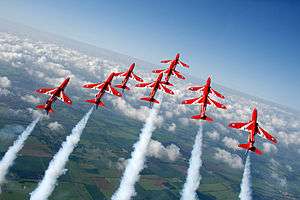RAF Scampton
| RAF Scampton | |||||||
|---|---|---|---|---|---|---|---|
| Near Scampton, Lincolnshire in England | |||||||
|
The Red Arrows at their home, RAF Scampton | |||||||
|
"Armed With No Provocation" | |||||||
 EGXP Shown within Lincolnshire | |||||||
| Coordinates | 53°18′28″N 000°33′03″W / 53.30778°N 0.55083°WCoordinates: 53°18′28″N 000°33′03″W / 53.30778°N 0.55083°W | ||||||
| Type | Royal Air Force station | ||||||
| Site information | |||||||
| Owner | Ministry of Defence | ||||||
| Operator | Royal Air Force | ||||||
| Website | RAF Scampton | ||||||
| Site history | |||||||
| Built | 1916 & 1936 | ||||||
| In use | 1916-1919 1936–present | ||||||
| Garrison information | |||||||
| Current commander | Wing Commander J. L. Campbell BA (Hons) MA RAF[1] | ||||||
| Occupants |
| ||||||
| Airfield information | |||||||
| Identifiers | IATA: SQZ, ICAO: EGXP | ||||||
| Elevation | 62 metres (203 ft) AMSL | ||||||
| |||||||
Royal Air Force Scampton or RAF Scampton (IATA: SQZ, ICAO: EGXP) is a Royal Air Force station located adjacent to the A15 road near to the village of Scampton, Lincolnshire, and 6 miles (9.7 km) north west of the county town, Lincoln, England. The current Station Commander is Wing Commander Joanne Campbell.[2]
The topography of the station in relation to the road has been incorporated into the station badge, in which the Longbow bowstring represents Ermine Street (the A15 road) bent to accommodate the lengthened runway, and the arrow representing the runway itself.[3] The site is owned by the Ministry of Defence and managed by the RAF.[4]
RAF Scampton stands on the site of a First World War Royal Flying Corps landing field, originally called Brattleby.[5] The station was closed and returned to agriculture following the First World War being reactivated in the 1930s. It has therefore provided an airfield for fighters in the First World War, bombers during the Second World War and V-force Avro Vulcans during the Cold War.
Since the temporary closure of RAF Scampton in 1996, and subsequent reactivation, the base has provided a home for the RAF Aerobatic team (RAFAT) the Red Arrows, and to other private companies, temporarily, such as Hawker Hunter Aviation, for the maintenance and storage of aircraft.[4][6]
The station was due to close in 2014 but in June 2012 the Ministry of Defence confirmed the Red Arrows would remain there until at least the end of the decade.[7]
First World War
Home Defence Flight Station Brattleby (also known as Brattleby Cliff) was opened on the site of the current RAF Scampton in late 1916. The airfield was bounded to the east by Ermine Street, to the south by Pollyplatt Lane, to the west by Middle Street, and to the north by Aisthorpe House.[4] The form of the airfield was very similar to that of Hackthorn Park to the north east, which is likely to have been created in the same way.[4] In addition to field boundaries, a number of other features were demolished or used for the airfield, including Aisthorpe House and a farm complex to the east of the site.[4] The aerodrome covered 287 acres consisting of a landing ground and six single-span end-opening General Service Flight Sheds arranged in pairs with their doors at 90-degrees to the landing ground. Technical buildings were set out behind these, followed by domestic accommodation close to Ermine Street. These were sub-divided into smaller groups depending on rank. Accommodation for women was based around a Women’s Hostel.[4]
The first operational unit was A Flight, 33 Squadron RFC (33 Sqn), which flew FE2bs defending against the Zeppelin threat.[5] The site then developed into a training aerodrome, supporting No. 60 Training Sqn, followed by No. 81 and No. 11 Training Sqns, flying the Sopwith Camel, Pup and Dolphin. The station was renamed as Scampton in 1917 following which it was designated as 34 Training Depot Station and continued with its operational programme until it was closed in April 1919.
All of the buildings on the airfield were temporary, even the hedgerows and trees which existed around the field boundaries were retained, so that between the wars the area was returned to its previous form. By 1920 all the buildings, including the hangars, had been removed.[8][9]
Inter-war period
By 1936 the RAF Expansion Scheme had overseen a period of rapid increases both in terms of new squadrons and the development of new stations.[4] The former Brattleby site was one of many earmarked under the expansion programme, situated between three villages; Aisthorpe, Brattleby and Scampton with its main entrance situated on the A15 road (Ermine Street) heading north from Lincoln. The site was to be constructed to the latest specifications and on completion would form a fully equipped Bomber Station. From its reopening in October 1936, the station was to be known as Royal Air Force Station Scampton.
The station consisted of four large C Type hangars with permanent brick-built technical and domestic buildings. The remaining aerodrome buildings (for technical activities and accommodation) were built in a compact layout behind the hangars, in an arrangement replicated across all of the Expansion Period airfields: Technical Area, Station Offices, Officers’ Mess, Sergeants’ Mess, Airmen’s’ Quarters, Married Quarters, and Officers’ Married Quarters.[4] Roads were arranged either parallel or perpendicular to Ermine Street (A15) with the Guardroom at 90-degrees to the main entrance and the Station Headquarters facing Ermine Street.[4] This resulted in the base occupying an area of 360 acres.[4]
As it developed, RAF Scampton made an increasingly dramatic imposition on the surrounding rural landscape[4] such as to the Lincolnshire Edge, a Jurassic limestone ridge, which forms the distinctive backbone of the county from Whitton on the Humber Estuary in the north, down to Grantham in the south.[4] Along the top of the Edge a series of airfields were developed, including RAF Waddington, RAF Cranwell and RAF Scampton.[4]
Upon opening IX(B) Squadron (9 Sqn) and 214 Squadron (214 Sqn) were the first residents of the station, arriving in October 1936, operating the Handley Page Heyford and Vickers Virginia. IX(B) Sqn stayed at Scampton until March 1938, 214 Sqn having departed for RAF Feltwell in April 1937. Another squadron which was stationed at the base was 148 Squadron (148 Sqn) formed from C Flt of IX(B) Sqn operating the Hawker Audax and later the Vickers Wellesley. The term of residence of 148 Sqn was brief being replaced by 49 Squadron (49 Sqn) and 83 Squadron (83 Sqn) in March 1938. At this time both 49 Sqn and 83 Sqn were operating the Hawker Hind before re-equipping with the Handley Page Hampden.[8][10]
Second World War
1939-1942
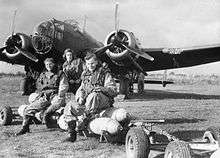
At the outbreak of the Second World War Scampton transferred to No. 5 Group RAF in Bomber Command, playing host to the Hampdens of 49 Sqn and 83 Sqn. On 3 September 1939, six hours after the declaration of war, RAF Scampton launched the first offensive by the Royal Air Force when six Hampdens 83 Sqn, led by (the then) Flying Officer Guy Gibson and three 49 Sqn Hampdens, one piloted by Flying Officer Roderick Learoyd, were despatched to conduct a sweep off Wilhelmshaven. Further operations involving Scampton's squadrons concerned them with the hazardous task of low level minelaying (code named 'Gardening',[11]) and the bombing of ships. Scampton squadrons were also involved during the critical stages of the late summer and early autumn of 1940, attacking barges in the channel ports which were being assembled as part of the invasion fleet.
For a short time the station played host to the Avro Manchester with 49 Sqn and 83 Sqn operating the type. This was a brief liaison with the squadrons subsequently converting to the Avro Lancaster. Forming 83 Conversion Flight (CF) on 11 April 1942, which in turn was followed by 49 CF on 16 May, both squadrons were fully equipped with the Lancaster by the end of June. It was during this period that 83 Sqn took delivery of Lancaster MkI R5868 which would one day become the Station's gate guardian.[12]
In turn both resident squadrons were then replaced at Scampton by 57 Squadron (57 Sqn).[9][11] The first departure was that of 83 Sqn which left in August 1942, transferring to RAF Wyton in order to become part of the fledgling Pathfinder Force. This departure resulted in 83 CF moving to RAF Wigsley where it was disbanded into 1654 Heavy Conversion Unit. On 2 January 1943, 49 Sqn departed for RAF Fiskerton with 49 CU disbanding, subsequently becoming 'C' Flight of 1661 Heavy Conversion Unit at RAF Waddington. By early January 1943 this left 57 Sqn as the sole occupier of the base.
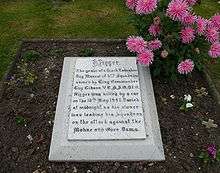
1943-1945
Following the development of the Upkeep bouncing bomb, 617 Squadron (617 Sqn), originally referred to as "Squadron X," was formed at Scampton in order to carry out the proposed raid, codenamed Operation Chastise. More commonly referred to as the "Dambusters Raid," the raid would go down as the most famous and widely remembered in the history of the Royal Air Force. On the night of 16–17 May 1943, 617 Sqn despatched 19 Lancasters from Scampton. Led by Wing Commander Guy Gibson, the main bulk of the squadron attacked the Sorpe, Eder and Möhne dams with an additional aircraft tasked to perform an attack on the Schwelm Dam.[13] Both the Eder and Möhne dams were breached, however eight of the Lancasters despatched failed to return and 53 aircrew were lost. Following the raid Wing Commander Gibson was awarded the Victoria Cross, becoming Scampton's third recipient of the award. On the day of the raid, Wing Commander Gibson's dog, Nigger, was run over and killed on the A15 outside the entrance to the base. He was buried later that night, his grave situated outside Gibson's office at No. 3 Hangar.[14]
_at_Scampton%2C_Lincolnshire%2C_22_July_1943_TR1127.jpg)
In July 1943 617 Sqn was again involved in a precision operation, when twelve aircraft of the squadron took off from Scampton to attack targets in Northern Italy, following which the aircraft continued on to North Africa. The operation met little opposition but the targets were obscured by valley haze and they were not destroyed. The 12 crews returned to Scampton on 25 July from North Africa after bombing Leghorn docks on the return journey. Later in the month nine aircraft took off from Scampton to drop leaflets on Milan, Bologna, Genoa and Turin in Italy. All aircraft completed the mission and again continued onwards to North Africa, where they all landed safely. Seven of the aircraft returned to Scampton on 1 August, one on 5 August and the last on 8 August.
At the end of August 1943,[15] 57 Sqn and 617 Sqn moved to RAF East Kirkby and RAF Coningsby respectively, so that Scampton's runways could be upgraded. With the increased all up weight of the Lancaster it was apparent that the load bearing of hardened runways would be required. The airfield closed at the end of August 1943 for the work to take place re-opening in October 1944. Three concrete runways were laid out in a traditional "A" Class bomber pattern. The three runways available were: 05/23 at 2,000 yd (1,828.8 m), 01/19 at 1,500 yd (1,371.6 m) and 11/29 at 1,400 yd (1,280.2 m). A total of 11 loop hard standings were laid down along the perimeter track to replace those lost or isolated by the construction. The work also saw new bomb stores constructed on land north of the north-west corner of the airfield. The personnel at Scampton at this time was given as 1,844 males and 268 females.[16]
On completion of the required work the area of land which the base occupied had now increased to 580 acres.[4]
Following the work control of the station passed from 5 Group to 1 Group[17] with a new arrival following the upgrade being 1690 Bomber Defence Training Flight (BDTF) which arrived on 13 July 1944. The BDTF consisted of Spitfires, Hurricanes and Martinets, the flight undertaking fighter affiliation against bombers. This unit stayed at the station until September 1944, when it moved to RAF Metheringham. It was replaced by 1687 BDTF which arrived in early December 1944, and departed for RAF Hemswell in April 1945.
Two Lancaster squadrons, 153 Squadron (153 Sqn), and later 625 Squadron (625 Sqn), of No. 1 Group RAF[18] also arrived at Scampton following the re-opening of the airfield.
The last bombing mission of the Second World War launched from RAF Scampton was on 25 April 1945, when aircraft from 153 Sqn and 625 Sqn were despatched as part of a raid on the Obersalzberg.[3]
Losses
During the war RAF Scampton lost a total of 551 aircrew and 266 aircraft.[3] Of these 155 were Hampdens and 15 Manchesters.[16] Some 96 Lancasters were lost on operations and accidents from April 1942 to May 1945. The highest losses were those of 57 Sqn, which lost 53 aircraft with 284 aircrew killed, 12 injured and 19 taken prisoner of war. In percentage terms Operation Chastise was the costliest single raid.
Post World War 2
Following the end of hostilities 153 Sqn disbanded on 28 September 1945, followed by 625 Sqn on 7 October. The station continued to operate the Avro Lancaster when 100 Squadron (100 Sqn) arrived in December 1945. They were to be the last Lancaster squadron on the station, departing for RAF Lindholme in May 1946. Returning to their former home in December 1945, 57 Sqn introduced the Avro Lincoln to the station. In time 57 Sqn also joined 100 Sqn at RAF Lindholme.
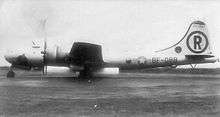
United States Air Force
From July 1948, Scampton housed Boeing Washingtons of the USAF 28th Bomber Group, as part of a network of Emergency War Plan Airfields.
With its main runway less than 6,000 ft in length and a chronic shortage of suitable hardstandings, Scampton was far from ideal as a base for the thirty Washingtons. In January 1949 as circumstances changed, the USAF Squadrons were withdrawn and Scampton was handed back to the Royal Air Force.[19]
Cold War
1950s
In 1953 Scampton became a Master Diversion Airfield and the Watch Office received a glass penthouse for use by the Local Controller. During this period RAF Scampton was supporting four Canberra squadrons;[20] 10 Sqn, 18 Sqn, 21 Sqn and 27 Sqn.[20] The Canberras moved out in 1955 when the station was earmarked as a V-bomber base.
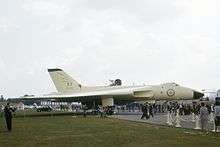
RAF Scampton was selected to be one of ten airfields which were to accommodate part of the RAF V-force, in the case of Scampton, the Avro Vulcan.[4] This required extensive new ground facilities, including a high security area for the storage and maintenance of nuclear weapons and heavy-duty hardstandings for the aircraft.[4] The first nuclear weapons to be delivered to Scampton arrived during 1958 and comprised twenty kiloton (20kt) atomic bombs given the Rainbow Code, Blue Danube. They were replaced by the smaller Yellow Sun Stage 1 (Mk. 1s) which were the first of the UK’s operational thermonuclear weapons. The development of the stand-off nuclear missile Blue Steel required the construction of new specialist buildings: the Missile Servicing and Storage Building (MSSB) which was erected between the main hangars and the airfield, and the highly volatile High Test Peroxide (HTP) and kerosene fuel storage buildings which were located at some distance from the MSSB.[4] Additional structures and parts of the layout were also altered. In particular the runway was rearranged to a NE/SW (current designation alignment 04/22)[21] and extended to 9000 ft (2740 metres). This caused the runway to project beyond the north east corner of the base and required the rerouting of Ermine Street (A15), the most noticeable artificial landscape feature in the area and the historic boundary for such elements as parish boundaries and field systems. Trees along the former tree-lined avenue to Hackthorn Park were also removed between the old line of Ermine Street and the end of the runway. The eastward bulge in the A15 road can still be seen north of Lincoln.[22]
During the Cold War period, the airfield developed its current form, imposing on the landscape in a much more spectacular way. Its extent was no longer bounded by pre-existing field boundaries, but by the shape required for the runway extension. This caused the southwest and northwest corners of the base to jut out from the earlier rectangular plan. Areas of hard standing with associated Operational Readiness Platforms (ORPs) were also provided. Technical buildings were also added to in this period. The Unit Storage buildings to the far north of the site were constructed for storage and maintenance of nuclear bombs. Upon the introduction of the Blue Steel stand-off missile, new buildings were constructed just to the north-east of the hangars, to develop, maintain and fuel the missiles. A new Control Tower was constructed close to these buildings to provide a view of the newly expanded runway. Domestic areas were developed as a response to the increased numbers of personnel using the site. These included new barrack blocks to the southeast of the hangar crescent and larger areas of family accommodation.
The work undertaken increased the land area of the station to 920 acres and on completion 617 Squadron returned to their former home, re-forming in May 1958.[20]
1960s
In October 1960 83 Squadron arrived at Scampton from RAF Waddington and equipped with the Vulcan B.2.[12] Together with 27 Squadron and 617 Squadron, who by this time had also taken delivery of the Vulcan B.2., the Scampton Wing was formed, the aircraft equipped with the Blue Steel stand-off missile. In April 1964, centralised servicing was introduced at RAF Scampton, meaning aircraft were no longer assigned to individual units but instead were ‘pooled’ and assigned to squadrons on a day-by-day basis. This meant that various Vulcans were flown by all three squadrons of the Scampton Wing, which was now was fully operational with Blue Steel.
On 30 June 1968, Blue Steel operations at Scampton were terminated, as the Royal Navy, with the submarine launched Polaris missile, assumed responsibility for the UK nuclear deterrent. Scampton squadrons were assigned to the tactical nuclear and conventional bombing roles. This led to the disbandment of 83 Squadron in August 1969, however in December 1969 230 Operational Conversion Unit moved to RAF Scampton from RAF Finningley.
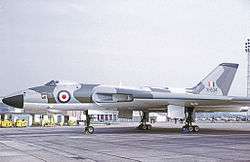
Part of the post-war development and upgrading of the station, in common with many other RAF Stations at the time, saw the establishment of a primary school for the children of those personnel stationed on the base.[23] Located to the south of the base entrance,[23] and adjacent to the eastern perimeter fence,[23] the current school was built in 1961 and replaced the makeshift schooling which had been provided in the Officer's Mess since 1951.[23] The official opening of the school took place on 24 November 1961,[23] and the first children attended the school in January 1962.[23] The buildings are typical of small primary schools built in the 1960s, with a flat roof, large windows and uniformly one storey high.[23] There are several prefabricated extensions which present an informal building layout.[23]
1970s
Individual unit allocations were re-introduced in 1971, and throughout the decade RAF Scampton continued to be home to 27 Squadron, 617 Squadron and 230 Operational Conversion Unit.
1980s
With disbandment of 230 Operational Conversion Unit and the cessation of 617 Squadron's Vulcan operations in 1981,[3] Scampton transferred to RAF Support Command and became home to the Central Flying School in 1983. This role for the station saw the CFS operating such aircraft as the Scottish Aviation Bulldog and the Short Tucano, sharing the air space with the Hawks of the Red Arrows. A further addition to the compliment of the station occurred in 1984 with the arrival of the Tornado Radar Repair Unit.[3]
Post Cold War
1990s
In the mid 1990s, Scampton was mothballed under the Front Line First programme, with the CFS moving to RAF Cranwell. The decision was initially taken to close the base completely along with RAF Finningley, this being confirmed by Nicholas Soames MP in a statement to the House of Commons to the effect on 25 March 1995.[24] Opposition to the planned closure was strong. A group was formed entitled "Save our Scampton" (SOS), backed by the Lincolnshire Echo, the County Council and the MP for Gainsborough and Horncastle, Edward Leigh.[24] One plan put forward for the base following its proposed redundancy involved turning the site into a prison, but this plan was not continued with.[25]
The Red Arrows, though, continued to train in the restricted airspace surrounding the airfield (R-313) and accommodation at Scampton continued to be used as overflow from RAF Waddington. During this intervening period approximately 20%[4] of the NCO married quarters were sold to the Welbeck Estate Group.
2000s
In early 2000 following a revaluation of the logistics of the Red Arrows' operation as well as the lack of available space at RAF Cranwell, it was decided to re-base the Red Arrows at Scampton.
As part of a reorganisation, Air Combat Service Support units of 2 Group and personnel from RAF Boulmer and RAF Sealand were planning to move to Scampton. This would have seen personnel levels on the station rising to 2,500[4] and as the retention of the base as an operational RAF Station was then looking uncertain, it was hoped that the decision would have led to making its future more secure. However, financial problems meant that infrastructure improvements were not possible and these units moved to RAF Leeming in North Yorkshire instead.
In 2005 Scampton was again placed under the control of RAF Strike Command, becoming home to the UK Air Surveillance and Control System (ASACS) Control and Reporting Centre (CRC) and Mobile Met Unit (MMU). The No1 Air Control Centre deployed to Afghanistan in 2006 as part of Operation Herrick, the deployment lasting until 2009.[3]
By 2008 the future once again looked uncertain for RAF Scampton.[26] A decision was taken by the then Labour Government that the base would be "down sized," the Red Arrows would move to RAF Waddington by July 2011[27] and the Air Surveillance and Control System (ASACS) would also be relocated from the base[26] taking up residence at RAF Coningsby by 2014.[28] However the Strategic Defence Spending Review and operations in Libya meant the plan was suspended with the decision put on hold pending a further review in 2011.[26] The review concluded that keeping the Red Arrows at RAF Scampton was the best way for them to operate, without affecting other operational flying bases.[26] As a consequence of the decision work was undertaken to resurface the runway, ensuring Scampton was retained as an operational flying base.
Present day

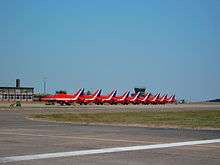
RAF Scampton is now the home to the Red Arrows, the Control and Reporting Centre Scampton and the Mobile Meteorological Unit.[3] As of 2016 the Red Arrows are the only permanent aircraft based on the station, although it is not uncommon to see RAF aircraft from other stations using Scampton for training operations. The current residents therefore provide a mix of fighter controllers, reservists and aircrew.
The Red Arrows fall under No. 22 Group, although RAF Scampton is actually administered by No. 1 Group.[29] The reason for this being that No. 1 Air Control Centre is a No. 1 Group air defence radar unit, with its permanent operations room, Control and Reporting Centre Scampton, providing assistance to the coverage at RAF Boulmer.[29] RAF Scampton's primary responsibility is training, but it can also provide defence coverage following any technical disruptions at RAF Boulmer.[29] Another responsibility of the station is the provision of deployable command and control capability using containerised equipment that can be delivered worldwide, thereby delivering similar capability to that of the permanent Control and Reporting Centres.[29] No. 1 Air Control Centre provides the main operational unit for fighter controllers and aerospace systems operators in the RAF.[30] Operators usually train at the Control and Reporting Centres of Boulmer and Scampton before putting their training into practice at 1ACC or on E3 Sentry Aircraft.[29]
The Mobile Meteorological Unit is staffed by full-time Reserve officers as part of the civilian Meteorological Office. The unit maintains and repairs equipment for the support of out of area flying operations.[29]
Until the closing of RAF Kirton in Lindsey RAF Scampton had administrative control over the satellite site, 15-miles to the north.[3][31]
In 2015 part of the accommodation facilities at RAF Scampton underwent significant refurbishment, particularly those of Gibson Barracks.[32] The improvements consisted of replacement of windows, refurbishment and repair of external concrete areas and provision of new escape stairs.[32] The barracks had lain unused for over 20 years,[32] and as a consequence of the neglect had fallen into a state of disrepair.[32] The building was converted into teaching space in the 1980s,[32] but with the subsequent lack of investment on the station the block was allowed to fall into disuse. Following a re-examination of the viability of the base undertaken following the closure of RAF Kirton in Lindsey and the resulting transfer of personnel, as well as the realisation by English Heritage of the importance of the structure and its association with the Dams Raid, it was decided to convert the block back to residential use.[32] Although the building is not a listed structure it is situated within a site of significant heritage value due to its links to Operation Chastise.[23][32] The accommodation consists of 48 bedrooms with communal facilities.[32]
Based at RAF Scampton
- Royal Air Force Aerobatic Team (The Red Arrows)
- Control and Reporting Centre
- 1 Air Control Centre
- Mobile Meteorological Unit
RAF Scampton VC recipients
During the station's history, three personnel based at RAF Scampton have been recipients of the Victoria Cross.
Wing Commander Roderick "Babe" Learoyd[33]
On 12 August 1940, 83 Squadron's aircraft were part of a raid against the Dortmund-Ems Canal.[33] Two aircraft had been lost due to anti-aircraft fire prior to Learoyd making his attack, which would involve an attack at low level.[33] During his attack, Learoyd's aircraft was caught in the searchlights, taking two hits in one wing.[33] Despite this Learoyd was still able to provide his bomb aimer with a steady platform in order to deliver his bombs.[33] Learoyd then nursed the Hampden back to England, arriving in the vicinity of Scampton at 02:00hrs. Although the aircraft was flyable, its hydraulic systems had been damaged and the wing flaps were inoperable. The undercarriage indicators had also failed and rather than risk a landing in the dark, Learoyd circled for three hours before making a landing at first light. He was awarded the Victoria Cross for his courage, skill and determination.[33]
Flight Sergeant John Hannah[34]

Wireless Operator/Air Gunner John Hannah was also a member of 83 Squadron.[34] On 15 September 1940 his aircraft was involved in a raid on a target near Antwerp during which the Hampden received a hit in the bomb bay, leading to an explosion and serious fire.[34] Both Sgt. Hannah's position and that of the rear gunner were engulfed in fire, and although the rear gunner had bailed out, Hannah elected to remain at his post, fighting the fire with extinguishers, and when these expired his log book.[34]
He successfully prevented the fire from reaching the aircraft's ruptured fuel tanks, despite ammunition exploding and the floor beneath him melting.[34] Although severely burned, Sgt. Hannah forced his way forward to the navigator's station, only to find the navigator had also baled out. He then passed the navigation logs and charts to the pilot and assisted him in navigating the Hampden back to Scampton.[34]
Wing Commander Guy Gibson[35]
_16_-_17_May_1943_MH6673.jpg)
On the night of 16-17 May 1943, Wing Commander Gibson led 617 Squadron on the raids against the Rhur Dams, Operation Chastise.[35] The task was fraught with danger and difficulty.[35] Wing Commander Gibson personally made the initial attack on the Möhne Dam. Descending to within a few feet of the water and taking the full brunt of the anti-aircraft defences, he delivered his attack with great accuracy. Afterwards he circled very low for 30 minutes, drawing the enemy fire on himself in order to leave as free a run as possible to the following aircraft which were attacking the dam in turn.[35] Wing Commander Gibson then led the remainder of his force to the Eder Dam where, with complete disregard for his own safety, he repeated his tactics and once more drew on himself the enemy fire so that the attack could be successfully developed.[35]
In July 2009 RAF Scampton took delivery of three bronze busts depicting the station's three Victoria Cross recipients.
Gate guardians

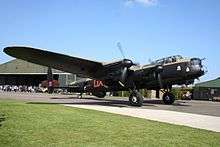
In all there have been three gate guardians at RAF Scampton during the Station's history.
Lancaster R5868 Q-Queenie/S-Sugar
The first was Avro Lancaster S-Sugar along with the large Tallboy and Grand Slam bombs which the type had carried.[36] In the late 1950s, as a preliminary to road widening work by Lincolnshire County Council, the Grand Slam bomb had to be moved. Efforts to lift it with a small crane proved futile, as it was much heavier than expected. Upon closer examination, it was found to be still filled with live explosives. It was carefully removed on an RAF low loader and detonated on a test range. It is unclear how a live bomb managed to be put on display, but it seems that it was in place for well over a decade.[37] With the arrival of 83 Squadron at Scampton in October 1960,[12] it was noted that S-Sugar had strong links to the squadron.[12] It transpired that the aircraft had originally served at Scampton with 83 Squadron and was given the squadron code OL-Q (Q-Queenie). When 83 Sqn converted to the Lancaster MkIII in September 1943,[12] Lancaster Q-Queenie was transferred to 467 Squadron who were then based at RAF Bottesford. The aircraft was subsequently re-coded PO-S (S-Sugar).[12] In view of the aircraft's history the 467 Sqn codes were removed and replaced by the original 83 Sqn OL-Q code. Lancaster R5868 was dismantled at Scampton in November 1970, by personnel from No 71 MU.[12] It was removed and is now on permanent exhibition at the Royal Air Force Museum, Hendon.[12]
Lancaster NX611 Just Jane
The next gate guardian was another restored Lancaster, repatriated from a French island in the South Pacific. This later Lancaster, Just Jane NX611, is now at the Lincolnshire Aviation Heritage Centre at the former RAF East Kirkby.
Hawk XX306
.jpg)
The current gate guardian at RAF Scampton is a former Red Arrows Hawk T.1 XX306.[38] Positioned in front of the Station Headquarters, it was unveiled by the then Station Commander Wing Commander Michael Harrop during a ceremony on 12 October 2015.[38]
The aircraft was constructed at BAe Dunsfold and handed over to the Royal Air Force on 23 May 1980.[38] The jet spent two months at RAF Valley before flying to RAF Kemble (the Red Arrows’ previous home) and joined the Squadron on 3 July 1980,[38] being one of the first of its type operated by the Red Arrows following their conversion from the Folland Gnat at the end of the 1979 display season.[38] During its operational life XX306 amassed a total flying time of 7,378hrs 15mins accumulating 13,007 landings.[38] It was retired from the aerobatic team on 20 October 2012, having last been used in a display on 26 September of that year.[38]
Former Station Commanders
- Air Cdre John Russell 1936–38
- Air Mshl Sir Hugh Walmsley CB CBE 1940–41
- Group Captain John Whitworth CB DSO DFC and Bar 1942-43
- Group Captain Adolphus Davies CB CBE 1943-44
- Group Captain John Merer CB 1944-44
- Group Captain Thomas Parselle CB CBE 1948-48
- Air Chf Mshl Sir David Lee GBE CB 1953–55
- Group Captain Hubert Connolly CB DFC and Bar AFC 1955-55
- Group Captain Stafford Coulson DSO DFC 1957–60
- Air Mshl Sir Harry Burton CB CBE 1960–62
- Group Captain Jack Garden 1962–63
- Air Cdre Allen Mawer DFC 1965–68
- AVM Jack Furner CBE OBE DFC 1968
- Air Mshl Sir John Fitzpatrick CB 1974–75
- AVM Allan Blackley CBE 1985–87
- Group Captain C Burwell 1994-95
- Wing Commander D Bolsover 2000-01
- Wing Commander Bill Ramsey 2001-03
- Wing Commander D Middleton 2005-05[39]
- Wing Commander M Harrop 2014-16
Scampton Airshow
| RAF Scampton International Air Show | |
|---|---|
 Logo for Scampton Airshow | |
| Genre | Air show |
| Dates | 9–10 September 2017[40] |
| Venue | RAF Scampton |
| Country | U.K. |
| Website | |
| http://scamptonairshow.com/airshow | |
On 19 February 2016, an announcement was made concerning plans for the creation of an airshow to take place at Scampton in 2017.[41] In the wake of the decision to discontinue with a display at RAF Waddington following the 2014 airshow, there was a high degree of dissatisfaction regarding the announcement.[41] The airshow had become one of the leading attractions in the UK during the summer months, the 2014 airshow at Waddington witnessed numbers in the region of 135,000 attending the display weekend, raising approximately £260,000 for Service and local charities.[42]
Following on from the announcement in February 2016 of the station staging an airshow in 2017, it was announced that the Royal Air Force Charitable Trust, organisers of the Royal International Air Tattoo have agreed to organise a new event at Scampton.[41] However, the requirements for the upgrading of the base's infrastructure so as to be able to stage such an event mean that no airshow will be able to take place until 2017.[41]
During the late spring of 2016 preparations continued for the organisation of the event and an official announcement was made at the Station Commander's Reception on 26 May.[43]The dates for the airshow were confirmed on 10 November, been set for 9–10 September 2017. A website also went live on 10 November, allowing tickets to be purchased online.[44]
RAF Scampton Heritage Centre
RAF Scampton is currently home to a heritage centre, detailing the Station's history and displaying several hundred artifacts including a Blue Steel Missile.[20] More ambitious plans were put forward in 2013 to turn part of RAF Scampton into a major tourist attraction.[45] This project is being driven by Lincolnshire County Council. It has been estimated that the total investment required for the complete plan would be £80 million, of that total £40 million would be required to complete the first phase, which concerns two hangars and the exhibition hall.[4] Such amounts will therefore be requiring substantial monetary grants from the UK National Lottery in order for it to succeed.[45]
The plans envisaged would see two of the Station's four hangars converted into exhibition halls and the Officer's Mess converted into a hotel.[45] Council officials have held talks with the Royal Air Force as well as the Defence Infrastructure Organisation,[4] which manages the MoD's estate, regarding the proposals which estimate the creation of 100 jobs locally and annual visitor numbers in the region of 200,000.[45] An independent study commissioned by Lincolnshire County Council in October 2013 concluded that the proposal is viable and that it has the potential to succeed.[45][46]
Exhibitions would focus on the Red Arrows, aviation in the First and Second World Wars, the Cold War as well as Lincolnshire's aviation engineering heritage and the Dambusters Raid.[45] It is hoped the project will secure the future of the base and compliment the proposals to establish an air show at Scampton. It was hoped that the facility would be opened by 2018 in order to mark the centenary of the creation of the Royal Air Force,[45] but it would appear that this is somewhat ambitious. The council's current idea is to operate the facility in tandem with continued military activity at the base.[45]
In popular culture
The remnants of a Roman Villa are situated to the southwest of RAF Scampton. Excavation of the site and its subsequent documentation were undertaken for Channel 4 television's Time Team programme.[4]
Dambuster's Commemorations
1991
In May 1991 RAF Scampton was the venue for a BBC broadcast of Friday Night is Music Night, set to coincide with the anniversary of the Dambuster's Raid. The transmission was from No 1 Hangar and of added interest was the arrival of a British Airways Boeing 747-400 (G-BNLT). The aircraft, a new addition to the British Airways fleet, had been named City of Lincoln in a ceremony held at RAF Coningsby after which it was flown to RAF Scampton. City of Lincoln is the same name as that bestowed on Avro Lancaster PA474 of the Battle of Britain Memorial Flight and both aircraft featured in the show, the BBMF's Lancaster in No 1 Hangar forming the focal point of the concert. The Boeing 747 was parked on Echo Dispersal and was made available for members of the audience to visit.
1993
A special commemorative BBC television broadcast of Songs of Praise marking the 50th anniversary of Operation Chastise was staged at RAF Scampton in 1993, in which Boeing 747-400 City of Lincoln returned to the base. Presented by Sally Magnusson, the event was attended by 2,500 invited guests, including several veterans of the raid as well as Leonard Cheshire VC and Richard Todd.
2013
Marking the 70th anniversary of the raid in 2013, the BBC again featured a programme from RAF Scampton, hosted by Dan Snow. Attended by Les Munro and "Johnny" Johnson, the telecast featured the Lancaster of the Battle of Britain Memorial Flight as well as two Tornados of 617 Squadron.[47]
In addition there was also a broadcast by BBC Radio 2 of The Chris Evans Breakfast Show in which Evans conducted interviews with various station personnel and current members of 617 Sqn.[48] Following the show Evans boarded Avro Lancaster PA474 of the Battle of Britain Memorial Flight and flew from Scampton to Biggin Hill which was the venue for a special edition of Friday Night is Music Night as part of the commemoration.[47]
See also
References
Citations
- ↑ http://www.raf.mod.uk/rafscampton/
- ↑ http://www.raf.mod.uk/reds/news/index.cfm?storyid=E0A73BDB-5056-A318-A890C7664EE850E3
- 1 2 3 4 5 6 7 8 "RAF Scampton - History". Royal Air Force. Retrieved 10 July 2016.
- 1 2 3 4 5 6 7 8 9 10 11 12 13 14 15 16 17 18 19 20 21 22 "RAF Scampton Feasibility Study". Lincolnshire County Council. 29 October 2013. Retrieved 10 July 2016.
- 1 2 Halpenny 1981, p. 161.
- ↑ Smith, Steve (23 August 2012). "Hawker Hunter Aviation". AeroResource. Retrieved 10 July 2016.
- ↑ "RAF units to remain at Scampton". Estate and Environment. Ministry of Defence. 18 June 2012. Retrieved 26 June 2012.
- 1 2 Halpenny 1981, p. 162.
- 1 2 "History of RAF Scampton". Royal Air Force. Retrieved 27 October 2008.
- ↑ "Pre-War Scampton". Royal Air Force. Retrieved 27 October 2008.
- 1 2 Halpenny 1981, p. 163.
- 1 2 3 4 5 6 7 8 "Avro Lancaster B.Mk.1 R5868/7325M: Museum Accession Number 74/A/12" (PDF). RAF Museum. Retrieved 10 July 2016.
- ↑ "Bomber Command No. 617 Squadron". Royal Air Force. Retrieved 10 July 2016.
- ↑ Halpenny 1981, p. 164.
- ↑ Battle of Britain TV (17 May 2013). "Dam Buster Pilot Interview Sqn Ldr Les Munro". Retrieved 10 July 2016 – via YouTube.
- 1 2 "RAF Scampton Heritage Centre: At War". Royal Air Force. Retrieved 10 July 2016.
- ↑ "Scampton". RAF Lincolnshire.info. Retrieved 10 July 2016.
- ↑ Halpenny 1981, p. 165.
- ↑ "Scampton". The Dambusters. Retrieved 10 July 2016.
- 1 2 3 4 "RAF Scampton Heritage Centre". Royal Air Force. Retrieved 10 July 2016.
- ↑ Burke, Damien. "Airfield Viewing Guide - RAF Scampton". Thunder & Lightnings. Retrieved 10 July 2016.
- ↑ Halpenny 1981, p. 167.
- 1 2 3 4 5 6 7 8 9 "RAF Scampton: Historic Characterisation" (PDF). Historic England. October 2004. Retrieved 10 July 2016.
- 1 2 "SOS team launches a counter attack". Lincolnshire Echo. 24 March 2009. Retrieved 10 July 2016.
- ↑ "Plans to make former RAF base a prison surprise owner". Lincolnshire Echo. 4 November 2008. Retrieved 10 July 2016.
- 1 2 3 4 "Red Arrows to remain at RAF Scampton in Lincolnshire". BBC News. 18 June 2012. Retrieved 10 July 2016.
- ↑ "Red Arrows RAF Scampton move plan to be reviewed". BBC News. 15 December 2011. Retrieved 10 July 2016.
- ↑ "RAF bases are to be scaled back". BBC News. 29 October 2008. Retrieved 10 July 2016.
- 1 2 3 4 5 6 Royal Air Force Salute. March 2013 (page 46)
- ↑ "No. 1 Air Control Centre". Royal Air Force. Retrieved 6 September 2012.
- ↑ Mills, Claire (6 April 2013). "Defence Estate Rationalisation" (PDF). Library of the House of Commons. Retrieved 10 July 2016.
- 1 2 3 4 5 6 7 8 "Dambusters leader Guy Gibson's building to be revamped". Scunthorpe Telegraph. 3 October 2014. Retrieved 10 July 2016.
- 1 2 3 4 5 6 Foxley-Norris, Christopher (2 February 1996). "Obituary : Wing Cdr Roderick Learoyd VC". The Independent. London, UK: INM. Retrieved 10 July 2016.
- 1 2 3 4 5 6 "John Hannah VC, RAF". BBC: WW2 People's War. Retrieved 10 July 2016.
- 1 2 3 4 5 The London Gazette: (Supplement) no. 36030. p. 2361. 25 May 1943.
- ↑ "Service Aviation News: In Brief". Flight. 79 (2716): 422. 30 March 1961. Retrieved 10 July 2016.
- ↑ "Grand Slam". Australian Armourers Association. Archived from the original on 18 September 2009. Retrieved 13 January 2012.
- 1 2 3 4 5 6 7 "RAF Scampton gets Red Arrows jet as new gate guardian". Royal Air Force. 12 October 2015. Retrieved 10 July 2016.
- ↑ Barrass, M. B. "RAF Station Commanders - Lincolnshire and East Midlands: RAF Scampton". Air of Authority – A History of RAF Organisation. Retrieved 10 July 2016.
- ↑ http://scamptonairshow.com/airshow
- 1 2 3 4 Pidluznyj, Stefan (19 February 2016). "New air show to be staged at RAF Scampton in 2017". The Lincolnite. Retrieved 10 July 2016.
- ↑ "News: RAF Waddington Air Show Supports Past, Present and Future Personnel". Waddington International Airshow. 16 December 2014. Retrieved 10 July 2016.
- ↑ http://www.raf-ff.org.uk/newsarchive.asp?info=Scampton+Airshow+Hold+the+date&start=0
- ↑ http://scamptonairshow.com/airshow
- 1 2 3 4 5 6 7 8 "Dream to turn Red Arrows' home into world attraction". Lincolnshire Echo. 20 October 2013. Retrieved 10 July 2016.
- ↑ "RAF Scampton - Feasibility Study for an Aviation Heritage Attraction and related Site Development Options" (PDF). Lincolnshire County Council. March 2013. Retrieved 10 July 2016.
- 1 2 "BBC Radio 2 to commemorate the 70th anniversary of the Dambusters Raid". BBC Media Centre. Retrieved 10 July 2016.
- ↑ "Dambusters: Chris Evans live from Scampton". Scunthorpe Telegraph. 17 May 2013. Retrieved 10 July 2016.
Bibliography
- Halpenny, B.B. Action Stations: Wartime Military Airfields of Lincolnshire and the East Midlands v. 2. Cambridge, Cambridgeshire, Patrick Stephens Ltd, 1981. ISBN 0-85059-484-7.
- Halpenny, Bruce Barrymore Action Stations: Wartime Military Airfields of Lincolnshire and the East Midlands v. 2 (1991) (ISBN 978-1852604059) With update Supplement
External links
| Wikimedia Commons has media related to RAF Scampton. |
- Airport information for EGXP at World Aero Data. Data current as of October 2006.
- RAF Scampton website.
- Read a detailed historical record about RAF Scampton.
- YouTube video of the equipment used by No. 1 ACC. Reported by British Forces News.
